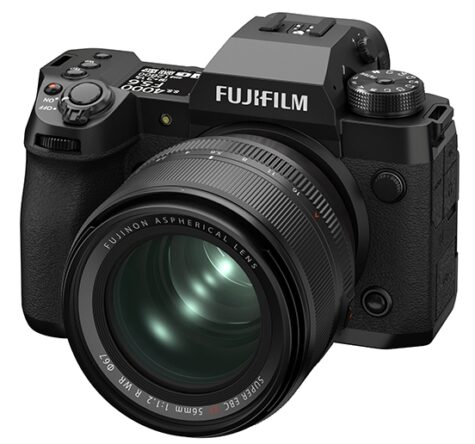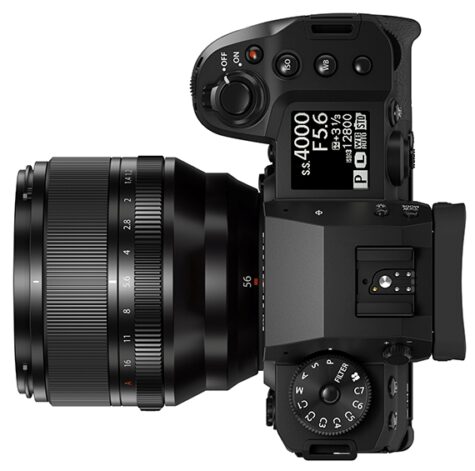FUJIFILM X-H2: Fujifilm’s 40-megapixel X-H2 camera offers the highest resolution to date for an APS-C camera, enabling users to record 8K/30p video and multi-frame composited 160-megapixel images. Target market is professional and serious enthusiast photographers who require a combination of high resolution for stills and video with a relatively compact camera body that can be used with a very wide range of lenses – Fujifilm makes its lens mount data available to third-party lens manufacturers, so there are plenty of options available outside its own, already substantial, range.
RRP: $3399 (body only); body with XF16-80mm f4 R OIS WR kit: $4249
 Announced in early September 2022, the X-H2 replaces the X- H2S as the flagship model in Fujifilm’s cropped-sensor camera line-up. Like the X-H2S, it features an X-Trans CMOS 5 BSI sensor; but it’s not stacked construction, as in the speed-biased X-H2S. Instead, the X-H2 is designed for high, 40-megapixel resolution. Like the X-H2S, the X-H2 can record files in HEIF 4:2:2 10-bit format as well as JPEGs and Fujifilm’s proprietary 14-bit RAF.RAW files. However, the new camera’s maximum burst speed is slower at a still impressive 20 fps. This is only available with the electronic shutter, which applies a 1.29x frame crop.
Announced in early September 2022, the X-H2 replaces the X- H2S as the flagship model in Fujifilm’s cropped-sensor camera line-up. Like the X-H2S, it features an X-Trans CMOS 5 BSI sensor; but it’s not stacked construction, as in the speed-biased X-H2S. Instead, the X-H2 is designed for high, 40-megapixel resolution. Like the X-H2S, the X-H2 can record files in HEIF 4:2:2 10-bit format as well as JPEGs and Fujifilm’s proprietary 14-bit RAF.RAW files. However, the new camera’s maximum burst speed is slower at a still impressive 20 fps. This is only available with the electronic shutter, which applies a 1.29x frame crop.
The combination of the 40-megapixel sensor with the high-speed X-Processor 5 image processor, which is also used in the X-H2S, makes the X-H2 the first of its type to support 8K video at up to 30 fps and deliver it with the full width of the sensor. The X-H2 also includes a 6.2K mode with a 16:9 aspect ratio, an improvement on the similar mode in the X-H2S, which produces output in a 3:2 ratio. High-resolution video is recorded in the ProRes 422 MOV format with H.265 compression and stored on the CFexpress card. Users can apply F-Log, F-Log2 and HLG (Hybrid-Log Gamma) adjustments to expand the dynamic range for movies to more than 13 stops when clips are edited. A full-sized HDMI port allows users to output an 8K ProRes RAW video stream to an Atomos Ninja V+ external recorder or, alternatively in BRaw format for those who use Blackmagic Video Assist.
The X-H2 is also the first model with a Pixel Shift Multi-Shot compositing function, which can produce a 160-megapixel image by combining 20 reference frames. This function is accessed via the Drive mode settings and shifts the sensor in half-pixel increments using the stabilisation system. The resulting frames are stored as RAF.RAW files. Photographers can choose from five shot interval options from ‘Short’ to 15 seconds. The resulting frames must be combined on a computer using Fujifilm’s free ‘Pixel Shift Combiner’ software.
A new focus meter display has been added to the Manual Focus assist functions and it can be used in tandem with focus peaking during movie recording to enable more precise focus adjustments. Otherwise, autofocusing is the same as in the X-H2S although the movie AF algorithm has been optimised for higher accuracy, particularly when shooting 8K movies.
The body of the X-H2 is almost identical to the X-H2S with the same weather-resistant sealing and controls interface. The viewfinder and screens are also the same, as are the dual card slots for SD and CFexpress Type B cards (required for 8K recording).
Purchasing Points:
1. The X-H2 is the first APS-C camera to offer 8K video recording, and also provides a 6.2K mode with a 16:9 aspect ratio, which is an improvement on the 3:3 aspect ratio for this mode in the X-H2S.
2. The X-H2 supports internal recording of 10-bit 4:2:2 video at 8K (7680 x 4320) and 6.2K (6240 x 3510) resolutions with a frame rate of 25 fps, along with both DCI and UHD 4K at 50p and 25 fps plus high-speed FHD at 200 fps. Long-GOP and All-I encoding are supported.

3. Professional codecs supported include Apple ProRes HQ, ProRes 422, ProRes LT and ProRes 422 Proxy, all with H.265 compression and 10-bit depth. Log recording modes in include r F-Log, F-Log2 and HLG (Hybrid-Log Gamma), which can expand the dynamic range to encompass more than 13 stops and provide greater flexibility for post-production workflows.
4. RAW video output is supported at 8-bit 4:2:2 and 10-bit 4:2:2 quality to Atomos and Blackmagic Design external recorders via the HDMI Type A connector.
5. Autofocusing is the same as in the X-H2S, with subject-detection AF based on Deep Learning technology that automatically detects and tracks human faces and eyes as well as animals, birds, cars, motorcycles, bicycles, airplanes and trains. The ability to track moving subjects in low-contrast environments has also been improved.
6. The X-H2 has the same weather-resistant body as the X-H2S, along with the same control layout, which makes swapping between the two cameras straightforward. The 5.76-million-dot OLED EVF and vari-angle touch-screen monitor are also the same and so are the dual memory card slots for SD and CFexpress Type B cards.
7. The in-body image stabilisation (IBIS) system provides up to seven stops of shake correction including with longer lenses. This function has been adapted to provide the new Pixel Shift Multi-Shot compositing mode, which can produce a 160-megapixel image by combining 20 reference frames. The frames must be combined with the ‘Pixel Shift Combiner’ software, which is available to download free of charge.
8. The X-H2 also provides panorama shooting modes – both vertical and horizontal – and multiple exposures with additive, average, bright and dark combination options
9. Both mechanical and electronic shutter options are available, with the mechanical shutter supporting continuous shooting at up to 15 fps for the full frame size, while the electronic shutter supports up to 20 fps with a 1.29x frame crop. The buffer memory can accommodate more than 1000 JPEG frames or 202 losslessly-compressed RAF.RAW frames and 136 uncompressed raw frames. Capacities are slightly lower with the electronic shutter.
10. The X-H2 accepts the same optional accessories as the X-H2S, including the dust- and moisture–resistant VG-XH vertical battery grip, FT-XH file transmitter with wired LAN connectivity and high-speed wireless communications, FAN-001 cooling fan and CVR-XH cover kit for protecting terminals on the camera.
Distributor: Fujifilm Australia; 1800 226 355; www.fujifilm.com.au
– Margaret Brown
 For a more extensive review, including performance charts, click here.
For a more extensive review, including performance charts, click here.





Just out of interest, does anyone actually use 6k or 8k for anything yet? I’ve not had a single request for delivery even in 4k. Could be handy for reframing and/or movement in post but most of the time we don’t bother and simply shoot in 1080 to save space and make the whole workflow easier.
Not sure I would call this a review as no comparisons but more a statement of specifications.
Also the author appears to work for the manufacturer.
Incidentally i will probably end up buying this model after peer reviews and empirical testing. Great comparisons can be made og the dpreveiw web site.